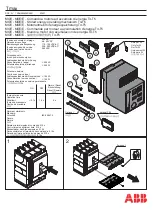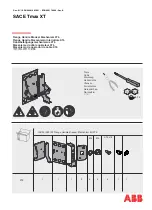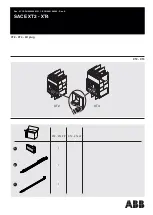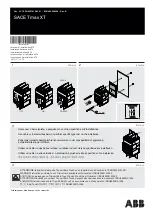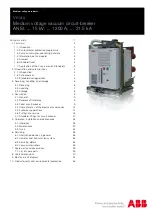
..
Type DK- 1 5 and DK-25 Air Circuit Breaker
Undervoltage Tripping Attachment
The undervoltage a t tachment i s normal ly mounted on the main panel
to the l ef t
of the breake r .
It operates to trip
the br eaker through the
trip bar if
the c ontrol
voltage drops
to a value of
35%
to
60%
of
rated
vol tage .
To check the adjus tment
of thi s a t t achment ,
r emov e the voltage
from the hold ing c oi l s ,
hold the armature again s t the magne t by hand ,
and
c l o s e the breaker .
Now allow
the armature
to move s lowly a.way from the
magne t under a c tion of the spr ing in the flexible l ink .
The breaker should
trip by thi s dead push .
Ad j u s tment to provide
thi s oper a t i on
i s made by
shortening or lengthening the flexible l ink detail .
When the undervoltage a t tachment
i s furni shed with
a time delay
tripping fea ture ,
the o il dash pot should be removed by uns c r ewing the p o t
when the above ad j us tment i s checked . Always c onne c t the undervol tage cells
to the l ine s ide of the breaker .
Reverse Current Attachment
The r evers e current attachment
(
Fig .
12-13 )
i s u s ed
to trip the
breaker when the dir e c t i on
of current flow in tha t pole i s rever s ed .
The
atta chment c ons i s t s of a magnet energi zed by a voltage c o i l and an armature
energized by a current c oil
in ser i e s wi th one pole of the breaker .
When
the seri es c oi l
current i s fl owing
in the proper
dire c t i on
the armature
tend s to rotate but is res trained by a s t op . When the s eri e s current is re
ver s ed the armature
i s r o ta ted in the opp o s i t e dire c t i on
again s t a spring
to trip the breaker .
Thi s adjus tment i s c a l ibrated and marked on the s cale
plate at
10%, 15% , 20%
and
25%
rever s e current ,
based on normal
current
rating .
The rever s e current armature
i s r e s e t after a tripping operation
by opening
the vol tage c o i l c ircui t .
Thi s c an be a c c ompl i shed
by wiring
the voltage c oil through an auxiliary swi t ch on the breaker .
Field Discharge Switch
The field dis charge c onta c t
(
Fig .
13-14)
i s normally mount ed on a
two pole breaker in the space left vacant abov e the breaker toggle linkag e .
Correc t ad jus tment in one dire c t i on
i s evidenced b y opening
o f the swi tch
c ontac t
j u s t pri o r
to the arc tips
touching during
the breaker
c l o s ing
mo tion . Similarly, the swi tch mus t make c ontac t before the breaker c onta c t s
part
more
than
1/8"
during the opening motion
of the b
r
e
a
k
e
r .
Auxiliary Switch
The
DK
auxil iary
sw itch
shown
in
Fig .
9
i s a
c ompac t molaed
a s sembly supplied in e i the r
4
to
8
pole s and is rigid ly mounted on the s ide
of the ma in bre aker frame .
Each pole cons i s ts of
tw o s ilve r po s t s
in
the
sec tions which carry
the terminal s c re w s on the reve rse
s ide .
The moving
c onta c t i s a s ilver bridging membe r, spring mounted on the s l id ing bar, and
w i th an e ccentric rolling moti on such
that adequa te w iping
ac tion take s
place when the switch c on ta c t i s made .
The terminal s cr ews are readily
a c c e s s ible on the c omple tely a s
s embled
b reaker and
adequate
wiring spa c e
i s provided
from the
swi tch
a s s embly through wiring hole s to the rear of the main panel .
Each four point swi tch
i s no rma lly H s s e!llbled wi th two "make 11 an�
two 11break 11 c ontac t s , but any pole may be r eversed
by r emoving the s liding
bar and inverting the bridging member , thus making pos s ib l e any des ired ar
rangement .
5
www
. ElectricalPartManuals
. com
Summary of Contents for DK-15
Page 13: ...w w w E l e c t r i c a l P a r t M a n u a l s c o m ...
Page 14: ...w w w E l e c t r i c a l P a r t M a n u a l s c o m ...
Page 15: ...w w w E l e c t r i c a l P a r t M a n u a l s c o m ...
Page 16: ...w w w E l e c t r i c a l P a r t M a n u a l s c o m ...
Page 24: ... w w w E l e c t r i c a l P a r t M a n u a l s c o m ...
Page 28: ...w w w E l e c t r i c a l P a r t M a n u a l s c o m ...
Page 30: ...w w w E l e c t r i c a l P a r t M a n u a l s c o m ...
Page 34: ...w w w E l e c t r i c a l P a r t M a n u a l s c o m ...
Page 36: ...w w w E l e c t r i c a l P a r t M a n u a l s c o m ...
Page 42: ...w w w E l e c t r i c a l P a r t M a n u a l s c o m ...
Page 43: ...w w w E l e c t r i c a l P a r t M a n u a l s c o m ...
Page 44: ...w w w E l e c t r i c a l P a r t M a n u a l s c o m ...
Page 52: ... w w w E l e c t r i c a l P a r t M a n u a l s c o m ...
Page 56: ...w w w E l e c t r i c a l P a r t M a n u a l s c o m ...
Page 58: ...w w w E l e c t r i c a l P a r t M a n u a l s c o m ...
Page 62: ...w w w E l e c t r i c a l P a r t M a n u a l s c o m ...
Page 64: ...I w w w E l e c t r i c a l P a r t M a n u a l s c o m ...
Page 70: ...w w w E l e c t r i c a l P a r t M a n u a l s c o m ...
Page 78: ...w w w E l e c t r i c a l P a r t M a n u a l s c o m ...
Page 82: ...w w w E l e c t r i c a l P a r t M a n u a l s c o m ...
Page 84: ...w w w E l e c t r i c a l P a r t M a n u a l s c o m ...
Page 88: ...w w w E l e c t r i c a l P a r t M a n u a l s c o m ...
Page 90: ...w w w E l e c t r i c a l P a r t M a n u a l s c o m ...
Page 96: ...w w w E l e c t r i c a l P a r t M a n u a l s c o m ...







































